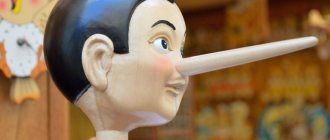We detect a liar by facial expressions
A combination of signs of deception shown by facial expressions and body language
- A momentary grin reveals a liar. If your communication takes place with a person who rarely smiles, then at the moment of lying you may notice a slight grin on his face. So a liar internally rejoices when he sees that his lie is believed.
- When a person lies, micro-tension of the facial muscles occurs, and this phenomenon lasts literally a few seconds. Only a very attentive interlocutor will be able to identify it in time.
- Frequent eye blinking can also indicate that you are being deceived.
- Pursed lips. The mouth becomes arched. Such facial expressions indicate puzzlement or regret. If during a conversation there are no such emotions, then pursing your lips may indicate a desire to lie.
- The appearance of distress on the face. It manifests itself as an involuntary raising of the eyebrows and the formation of a frontal fold. Asymmetry may also occur when emotions are expressed differently on the right and left sides of the face.
How to recognize a lie by facial expressions?
Let's consider the features of the facial expressions of a person who is trying to lie or telling the truth:
- human muscles on the face usually work synchronously, giving out any emotions, however, in a deceiver who only demonstrates feelings, the smile or eye expressions look asymmetrical;
- it is difficult for a sincere interlocutor to maintain external manifestations of feelings for longer than 5-10 seconds, since genuine emotions are short-lived, unless we are talking about depression, rage or deep ecstasy;
- eye expressions or a smile should coincide with the verbal manifestation of emotionality, and the delay is more likely to indicate falsehood.
About smile and falsehood
A smile, which is one of the main means of human communication, from the first days of his life to old age, has always deserved special attention from psychologists in the area of expressing lies through facial expressions.
Few people know that the very mechanism of action of the muscles responsible for smiling is aimed not only at creating friendly relations between interlocutors. Even for a baby who communicates with his parents through a smile, this facial expression helps relieve nervous tension. Being a tool for relieving emotional stress, a smile involuntarily appears on a person’s lips even at the moment of tragic news being announced. Many people perceive such facial expressions as stupidity or disrespect, but such a sign only indicates the healthy functioning of the nervous system, which deceives the brain and hides true emotions.
This is why many deceivers smile at times of stress, involuntarily trying to relieve tension. Some are able to do this deliberately, falsely replacing their true feeling of guilt with a more socially acceptable emotion - joy. At the same time, psychologists have found that real smiles appear on people’s faces just as often as fake ones. In general, more than 50 types of smiles are classified, among which truly deceitful ones are distinguished, as well as insincere ones, but showing politeness and ethics.
Features of the look
- You can also tell a liar by your eyes. First of all, this is indicated by a running glance. Undoubtedly, such a phenomenon may be a sign of excessive shyness or a feeling of confusion. However, if you note these manifestations, it is still worth questioning what your friend says.
- Staring can also indicate that you are being lied to. In this way, the interlocutor is trying to track how you react to what he is telling, whether you believe his words or not.
- If during a conversation you notice that your opponent’s pupils are dilating, he may be deceiving you. Unless it reflects a normal reaction to the topic of conversation.
Speech of the Deceiver
- When a person lies, the intonation in his voice changes. He may begin to speak faster or slower, in higher or lower tones; it is possible that the voice will tremble, change timbre, appear hoarse or high notes, as well as stutter.
- Reservations. During times of excessive excitement, an individual may slip into incorrect phrases. But it is not necessary that you are being deceived. In such a situation, you need to evaluate the overall picture as a whole. Thus, clauses can be of two types: semantic and phonetic. The first appear when a semantic replacement of a word occurs, the second - when one word is replaced with a similar sound.
- Pause. If, while answering a question, a person becomes silent for a while and then expresses his opinion, then it is possible that the pause was needed in order to come up with something, that is, to lie.
- Repeating phrases heard from the interlocutor. A situation when an individual answers you with the same words that were posed in the question. Such repetitions indicate that, most likely, in this way he is gaining time to think about his lies.
- Excessive talkativeness, especially in a person who has not previously been observed to be so, may indicate that he is chattering to hide a lie or is uttering a memorized false text.
How to recognize a lie by the eyes?
It is not for nothing that people of the old school try to find out the truth, forbidding the potential deceiver to look away. The eyes are truly the “mirror of the soul”, reflecting the inner state of a person. You can also see from them whether the interlocutor lied or not:
- in a standard situation during a conversation, people often maintain visual contact, meeting their partner’s eyes for 70% of the entire communication time, while liars are not able to withstand even 30%;
- in response to a question about hidden information, deceivers avert their eyes or show concern when their gaze begins to dart around in confusion;
- if a lie makes a person feel guilty or stressed, his eyes immediately begin to shine and his pupils dilate;
- during deception, women tend to look up and slightly to the right, men - down and to the left, which is due to the peculiarities of perception and processing of information characteristic of each gender.
Stress not only affects your opponent's gaze, but also his body language. Therefore, it is important to know how to determine by gestures that a person is lying.
Gestures of deception
Touching your nose during a conversation is a sign of deception.
Let's figure out how you can understand from a person's actions that he is deceiving; we recognize lies by gestures.
- During a conversation, the interlocutor touches his face.
- When talking, an individual involuntarily tries to cover his mouth with his hands. In essence, he is trying to close it so that the lie does not come out.
- Touches the nose, earlobes.
- While talking to you, the individual begins to rub his eye.
- Gestures widely with hands when it is inappropriate.
- He behaves stiffly, his movements are constrained. There are practically no gestures. Perhaps he is ashamed of his deception. Or he is afraid to give himself away with any movement.
However, you need to understand that gestures alone cannot be the only criterion for identifying a liar. The fact is that a person can rub his eye, for example, because he wants to sleep or something has gotten there, or an eyelash has bent. This is not always a sign of deception.
Physiology and body language
- Profuse sweating. If you know that the person you are talking to does not sweat in everyday life, and you notice that in a particular conversation he is sweating a lot, you may be being deceived. Although it is possible that he got sick.
- Head nods. When asking your interlocutor a question that may have a one-word answer, watch his reaction. If he answers “yes” but at the same time waves his head from side to side, he does not agree with his words. If he says “no” and nods at that moment, he’s lying.
- Fidgety behavior, nervousness, inability to sit still, or unusual posture may indicate that the person is not sincere.
- A person who tells the truth is turned towards his interlocutor and may lean towards him during a conversation. If he cheats, on the contrary, he will move away.
- Rapid breathing and frequent swallowing of saliva may also indicate that a person is deceiving and is worried that his lie will be discovered.
- Crossed arms. First of all, such phenomena indicate a feeling of discomfort. Perhaps the interlocutor is in danger from the environment, in this way he protects himself. However, if such a manifestation occurs at the moment of answering the question posed, most likely he is lying. If he stood with his arms crossed during the entire conversation, it is possible that he was simply cold or did not feel openness towards you, perhaps he did not trust you.
- Half a turn. If an individual turns slightly in the other direction or turns his head to the side while answering a question, he may be lying.
- Hands in pockets. An individual may hide his hands or put them behind his back when he is insincere.
Signs of lying in correspondence
In the era of the Internet and social networks, you have to communicate with a person by correspondence. Without seeing the interlocutor, without hearing his voice, it is difficult to figure out whether he is telling the truth or not. However, there are several signs by which you can suspect deception.
READ How to learn to say no to people: finding the root cause and methods of getting rid of the problem
Long set
If the opponent does not answer for a long time, this indicates a deliberate delay. You need to come up with and correctly formulate an answer so as not to give yourself away or sow mistrust. A pause in telephone communication will help you recognize insincerity.
Corrections, removals
The situation is similar. The partner is thinking about how best to lie. First one thought comes to mind, then another. A person corrects the text, corrects sentences, changes his opinion. Often a message that has already been sent is deleted with the hope that the interlocutor on the other side of the monitor did not have time to read it.
It is quite easy to identify such deceivers. You just need to observe their behavior during correspondence. Caught in a lie is not as difficult as it initially seems.
Phrases in discord
When a person who has clearly expressed his thoughts begins to get lost and writes inconsistently, this means one of two things: he is lying or is intoxicated. First he says one thing, then another, then he tries to justify himself, and the result is a pun. This is a sign that should alert you.
The role of the fool
The technique is used very often. Speaks of outright lies and the interlocutor’s intention to stall for time. In such cases, the phrases “forgot”, “completely tired”, “went out of my head” are heard. It is very easy to deceive in this way, but it is also not difficult to identify a liar.
Appeal to conscience
In SMS it looks like a reproach. The partner is trying to put pressure on his conscience, to make him feel ashamed, so that he stops interrogating: “I trusted you, but you did that!” Thank you!". After such a phrase, a predictable reaction appears - an apology from the “attacker.”
Warnings
You can misinterpret a sign and in vain accuse a person of lying
- You shouldn’t be overly suspicious and look for deceivers in everyone you know.
- Remember that no method gives a 100% guarantee of identifying a liar.
- Signs of deception can appear in groups, or they can occur individually. Therefore, sometimes it is difficult to determine whether a person is lying to you or not.
- Remember that people are individuals. Each individual can digest information and react to it in their own way. The signs of lying shown by individual people may also differ. Some will easily deceive, while others will not be able to do it at all.
- You may encounter a person who lies on a professional level. It will be almost impossible to recognize his deception. But even here you can try to bring the person to clean water by asking additional questions. Perhaps he will get confused in his lies.
- You need to understand that nonverbal signals do not in all cases confirm a lie. In some cultures, for example, staring at your interlocutor is bad manners.
- Signs of lying, manifested at the physiological level, for example, increased sweating, may not be a symptom of deception at all, but of problems with the health or physiological characteristics of the body of a particular person.
Now you know how to recognize a lie by facial expressions and gestures, behavior, words and looks. You will be surprised how often we are deceived in everyday life. Remember that lies are sometimes good. Perhaps a person is hiding something because he does not want to hurt his interlocutor. However, there are times when it is better to know that you are being lied to. It is possible that they want to harm you with such actions.
The psychology of lying: how gestures and facial expressions give us away
“Body language doesn’t lie. Even if the body is already in the grave,” Dr. Lai
In nature, no two people are the same. We are all different. We see, hear and think differently. And we also have different times. Therefore, there is no standard set of lying gestures indicating that we are telling a lie. But if he had, we would have found a way to deceive him.
Deception is noticeable when it evokes emotions (excitement, fear or shame). These emotions are conveyed by the language of gestures and facial expressions. But confirmation of a lie must be sought in the totality of facial expressions, gestures and speech.
The truth is somewhere on the left
Lying requires self-control and effort. Tension can be obvious or hidden, but it is easy to notice by looking closely at the left side of the body. It is less controlled than the right one. This is because the left and right sides of the body are controlled by different hemispheres of our brain.
The left hemisphere is responsible for speech and mental activity, the right hemisphere for emotions and imagination. Since control connections intersect, the work of the left hemisphere is reflected on the right side of the body, and the right hemisphere is reflected on the left.
What we want to show to others is reflected on the right side of our body, and what we actually feel is reflected on the left.
For example, if a person is right-handed and gestures a lot with his left hand, this may mean that he is lying, especially if his right hand is used less. Any inconsistency between body parts indicates insincerity.
“The brain is so busy making up lies that the body gets out of sync.” Dr. Lai
The face, like the body, conveys two messages at once - what we want to show and what we would like to hide. Disharmony in facial expressions indicates a contradiction. Symmetry always speaks of purity of intentions.
For example, if a person smiles, and the left corner of his mouth is raised less than the right, then, obviously, what he hears does not make him happy - he is feigning joy. It is also interesting that positive emotions are reflected evenly on the face, while negative ones are more noticeable on the left side.
Deception is annoying
Changes in complexion (pallor, redness, spots) and twitching of small muscles (eyelid, eyebrow) indicate stress experienced by a person and help to detect deception.
Tension, which manifests itself in frequent blinking, squinting or rubbing your eyelids, is an unconscious desire to close your eyes to what is happening. With rubbing gestures, our brain tries to block a lie, doubt or unpleasant sensation.
How comfortable or uncomfortable the interlocutor is can be judged by his pupils: their narrowing indicates dissatisfaction, dilation indicates pleasure. And by his eye movements it is easy to understand whether he is going to tell the truth or lie.
“Many people tend to consider shifting eyes as evidence of a bad conscience. But, as you know, notorious scoundrels can calmly look you in the face.” Agatha Christie
If a person averts his eyes, this does not mean that he is insincere. Often the one who looks intently into the eyes, trying only to appear open, is not completely honest.
A lie on the tip of your nose
Unexpectedly, the deceiver’s own nose can give him away. By telling a lie, he unconsciously begins to move the tip of his nose and move it to the side. And people who doubt the honesty of their interlocutor may involuntarily flare their nostrils, as if saying: “I smell something fishy here.”
The nose is generally extremely sensitive to deception: it itches and even enlarges (“Pinocchio effect”). Scientists have found that deliberate lying increases blood pressure and stimulates the body's production of catecholamine, which affects the nasal mucosa.
High blood pressure affects the nerve endings in the nose, causing it to itch. Gestures that somehow involve “rubbing,” such as someone rubbing their eyes, touching their nose, and scratching their neck, indicate insincerity.
And the pens - here they are
When the interlocutor puts his hands in his pockets and closes his palms, these are gestures of lies or insincerity: he is hiding something or not saying anything. Remember children: they hide their hands in their pockets or behind their backs if they have done something wrong.
Hidden palms can be compared to a closed mouth. Experienced salespeople always look at the client’s palms when they talk about refusing a purchase. True objections are made with open palms.
And with a hand covering his mouth, a person restrains himself so as not to say anything unnecessary. Afraid of spilling the beans, he unconsciously tenses his lips or bites them. Watch your interlocutor's facial expressions: a pursed lower lip indicates a contradiction: the person is not sure of what he is saying.
“People lie freely with their mouths, but the faces they make at the same time still tell the truth,” Dr. Lai
The way he sits can also tell a story about your interlocutor. If he chooses an unnatural position and cannot sit down, this indicates that he is uncomfortable with the situation or the topic raised.
Liars often bend over, cross their legs and arms, and seek outside support, leaning on some object (table, chair, briefcase). Truthful people rarely change their body position and stand straight when answering questions.
There's no honesty in "honestly"
Our speech is no less eloquent than the language of gestures and facial expressions. If you receive an evasive answer to a direct question, accompanied by the expression “to be honest,” then listen to the speech of your interlocutor. It is worth doubting his sincerity when repeating phrases like:
- You just have to trust me...
- Believe me, I'm telling the truth...
- You know me, I am not capable of deceiving...
- I am absolutely frank with you...
“You said it once - I believed it, you repeated it and I doubted it, you said it a third time and I realized that you were lying,” said the Eastern sages.
“There are more pauses in a false story than in a true story,” concluded Professor Robin Lickley. An overly detailed story is also unlikely to be true - unnecessary details only create plausibility.
A change in the rhythm and timbre of the voice can also give away deception. “Some people are always slow with the next sentence. If they start chattering, it’s a sign of lying,” says Paul Ekman.
When we tell the truth, we use gestures to reinforce what is said, and the gestures match the tempo of the speech. Gestures that do not fall in time with speech indicate a contradiction between what we think and say, i.e. to lies.
If you think the other person is lying:
- Adapt to him: copy his posture and gestures. By mirroring, you will establish trust and make it more difficult for the deceiver to lie.
- Don't expose him and don't blame him. Pretend you didn’t hear and ask again. Give the other person a chance to tell the truth.
- Ask more direct questions. Actively use facial expressions and gestures, causing him to respond.
Interesting facts about how we time
Cornell University communications professor Jeffrey Hancock studied 30 college students over the course of a week and found that the telephone was the most common means of deception.
People lie on the phone 37% of the time. This is followed by personal conversations (27%), online messengers (21%) and emails (14%). We feel more responsible for what we write than for what we say.
Outgoing people lie more often than introverted people, and they feel more comfortable lying and persist longer in their lies.
Psychologist Bella DePaulo came to the following conclusions:
Men and women lie equally often, but women usually do this to make the interlocutor feel more comfortable, and men - to present themselves in a more favorable light.
Men and women behave differently when they lie. Telling lies makes women feel less comfortable than men.
Scientists have found that a person begins to lie after his thinking reaches a certain level of development, approximately this occurs at the age of 3-4 years.










